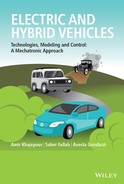Preface
Concerns over the environment, public health and the availability of fossil fuels have forced the establishment of aggressive emissions regulations, such as the U.S. 2020 CAFE Standards, and have triggered momentous changes in global automotive strategies. New technologies and products are now required to enhance fuel efficiency and reduce harmful emissions, without sacrificing performance, cost-efficiency and safety.
Vehicle electrification and hybridization have been increasingly recognized as the most promising road transportation solutions to both the global energy crisis and the increasingly stringent requirements related to environmental protection and vehicle safety. However, the electrification of automotive systems presents significant design challenges, specifically related to drivetrain systems, chassis design and layout, multidisciplinary power management and optimization, system integration, and vehicle dynamics and control.
Electric and hybrid electric vehicles (EVs and HEVs) are complex mechatronic systems; their design requires holistic consideration of vehicle and tire dynamics, powertrain, electric motors and batteries, and control and estimation modules that are integrated through millions of lines of computer code. Several books have already been published that outline very well the electrical aspects of EV and HEV platforms. In this book, we have expanded upon these early works to present a more comprehensive perspective that combines electrical, control, and dynamics in systems-level design. It places new emphasis on how dramatically vehicle dynamics and, subsequently, our understanding of conventional vehicle design is changed by electrification.
This book is structured to address both senior undergraduate and graduate level courses, and can serve as an excellent reference for anyone with a background in dynamics, electrical, and control engineering. The content is sufficiently broad to allow course instructors the opportunity to tailor the material according to students' backgrounds. Several introductory chapters provide important background information on vehicle technologies in propulsion, powertrain, body and chassis, and the evolution of automotive technology design from conventional vehicles to the HEV and EV models we see on the road today. Students with electrical and control engineering backgrounds, but limited experience with automotive and mechanical engineering applications will benefit from these initial chapters, while students with stronger automotive backgrounds will benefit from later chapters that focus on HEV and EV power management optimization and vehicle control.
In this book we have tried our best to ensure students are presented with a balance between building a solid conceptual understanding and developing procedural skills related to automotive design. Examples are presented throughout that encourage students to apply their theoretical knowledge to real EV and HEV design challenges and considerations specific to these vehicles. End-of-chapter problems are provided for further practice and to facilitate a better understanding of the materials.
